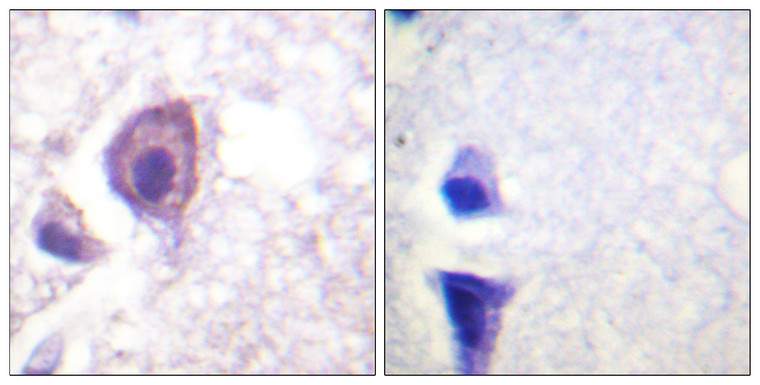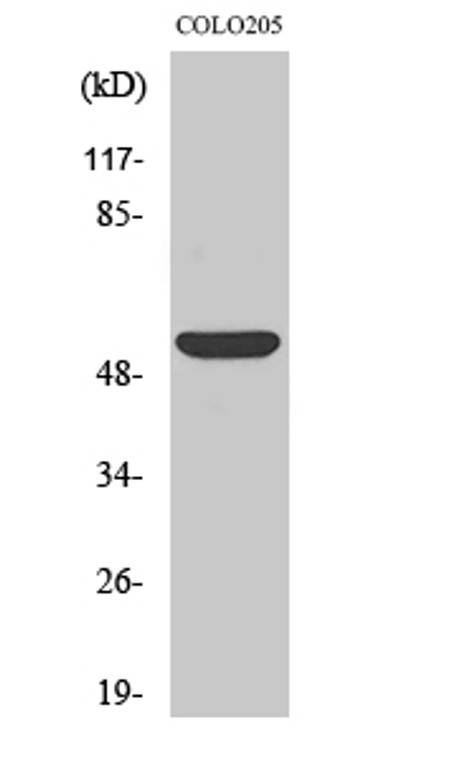| Host: |
Rabbit |
| Applications: |
WB/IHC/IF/ELISA |
| Reactivity: |
Human/Mouse |
| Note: |
STRICTLY FOR FURTHER SCIENTIFIC RESEARCH USE ONLY (RUO). MUST NOT TO BE USED IN DIAGNOSTIC OR THERAPEUTIC APPLICATIONS. |
| Short Description: |
Rabbit polyclonal antibody anti-T-cell surface glycoprotein CD4 (401-450 aa) is suitable for use in Western Blot, Immunohistochemistry, Immunofluorescence and ELISA research applications. |
| Clonality: |
Polyclonal |
| Conjugation: |
Unconjugated |
| Isotype: |
IgG |
| Formulation: |
Liquid in PBS containing 50% Glycerol, 0.5% BSA and 0.02% Sodium Azide. |
| Purification: |
The antibody was affinity-purified from rabbit antiserum by affinity-chromatography using epitope-specific immunogen. |
| Concentration: |
1 mg/mL |
| Dilution Range: |
WB 1:500-1:2000IHC-P 1:100-300ELISA 1:20000IF 1:100-300 |
| Storage Instruction: |
Store at-20°C for up to 1 year from the date of receipt, and avoid repeat freeze-thaw cycles. |
| Gene Symbol: |
CD4 |
| Gene ID: |
920 |
| Uniprot ID: |
CD4_HUMAN |
| Immunogen Region: |
401-450 aa |
| Specificity: |
CD4 Polyclonal Antibody detects endogenous levels of CD4 protein. |
| Immunogen: |
The antiserum was produced against synthesized peptide derived from the human CD4 at the amino acid range 401-450 |
| Post Translational Modifications | Palmitoylation and association with LCK contribute to the enrichment of CD4 in lipid rafts. Phosphorylated by PKC.phosphorylation at Ser-433 plays an important role for CD4 internalization. |
| Function | Integral membrane glycoprotein that plays an essential role in the immune response and serves multiple functions in responses against both external and internal offenses. In T-cells, functions primarily as a coreceptor for MHC class II molecule:peptide complex. The antigens presented by class II peptides are derived from extracellular proteins while class I peptides are derived from cytosolic proteins. Interacts simultaneously with the T-cell receptor (TCR) and the MHC class II presented by antigen presenting cells (APCs). In turn, recruits the Src kinase LCK to the vicinity of the TCR-CD3 complex. LCK then initiates different intracellular signaling pathways by phosphorylating various substrates ultimately leading to lymphokine production, motility, adhesion and activation of T-helper cells. In other cells such as macrophages or NK cells, plays a role in differentiation/activation, cytokine expression and cell migration in a TCR/LCK-independent pathway. Participates in the development of T-helper cells in the thymus and triggers the differentiation of monocytes into functional mature macrophages. (Microbial infection) Primary receptor for human immunodeficiency virus-1 (HIV-1). Down-regulated by HIV-1 Vpu. Acts as a receptor for Human Herpes virus 7/HHV-7. |
| Protein Name | T-Cell Surface Glycoprotein Cd4T-Cell Surface Antigen T4/Leu-3Cd Antigen Cd4 |
| Database Links | Reactome: R-HSA-1462054Reactome: R-HSA-167590Reactome: R-HSA-173107Reactome: R-HSA-180534Reactome: R-HSA-202424Reactome: R-HSA-202427Reactome: R-HSA-202430Reactome: R-HSA-202433Reactome: R-HSA-389948Reactome: R-HSA-449836Reactome: R-HSA-8856825Reactome: R-HSA-8856828 |
| Cellular Localisation | Cell MembraneSingle-Pass Type I Membrane ProteinLocalizes To Lipid RaftsRemoved From Plasma Membrane By Hiv-1 Nef Protein That Increases Clathrin-Dependent Endocytosis Of This Antigen To Target It To Lysosomal DegradationCell Surface Expression Is Also Down-Modulated By Hiv-1 Envelope Polyprotein Gp160 That Interacts WithAnd Sequesters Cd4 In The Endoplasmic Reticulum |
| Alternative Antibody Names | Anti-T-Cell Surface Glycoprotein Cd4 antibodyAnti-T-Cell Surface Antigen T4/Leu-3 antibodyAnti-Cd Antigen Cd4 antibodyAnti-CD4 antibody |
Information sourced from Uniprot.org
12 months for antibodies. 6 months for ELISA Kits. Please see website T&Cs for further guidance












